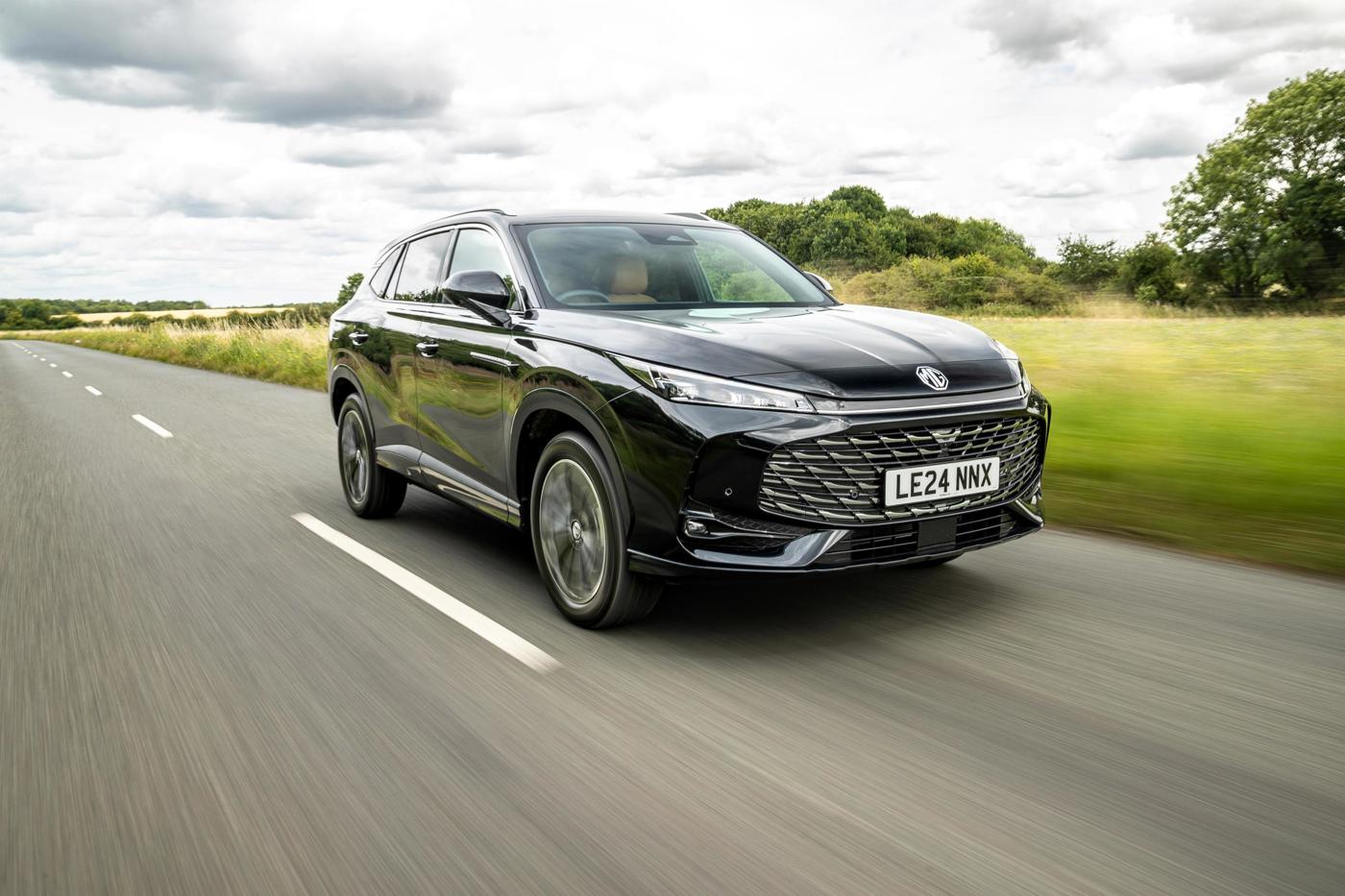Review
Fleet customers will be hard-pressed to overlook the new HS PHEV as it represents exceedingly good value for money.
Overview
MG is rapidly becoming one of the UK’s top-performing car brands and the HS is currently its most popular model.
Competing against the top-selling Kia Sportage and Nissan Qashqai, MG’s mid-size SUV has been replaced by an all-new version after just five years on sale.
The new car is larger, more modern and, crucially, more European in look and feel.

Pricing remains incredibly cheap, at £24,995 for the base version, which puts it closer in cost to smaller models like the Nissan Juke.
A key highlight of the new HS is an updated plug-in hybrid (PHEV) engine with a 75-mile range, placing it in the 5% benefit-in-kind tax band. These cost only £31,495.
MG has also equipped the car with more up-to-date infotainment and connectivity solutions.
The model line-up is pretty straightforward. There’s a regular petrol or the PHEV, in either SE or Trophy trim.
Specification levels are generous, with key safety and infotainment features shared across both models. The Trophy gains heated front seats, an electric tailgate and a 360-degree camera system
Comfort and practicality
Now longer and wider than before, the MG HS has more interior space along with a vastly improved cabin.
Higher quality materials are used throughout and the dashboard design and layout is more modern and upmarket.
The entire car has a more premium feel, although its still a cheap car so don’t expect BMW levels of quality.
The front seats are electrically adjustable and offer good support. SE models get cloth upholstery, while the Trophy has fake leather.
In the rear, there’s a generous amount of space. The car’s floor is completely flat, which means three people can sit across the rear bench in comfort.
Boot space is a reasonable 507 litres. While that’s not the best in the class, it’s still family friendly. Those that opt for the PHEV don’t have to sacrifice any luggage space, either, as it offers an identical volume.
The rear seats have a 60:40 split, and fold (almost) flat, but they don’t slide or offer any other adjustments. There’s a pair of cupholders in the rear armrest and some small door bins, but not as much interior storage space as rivals offer.

Safety and technology
MG has continued its digital-first approach to interior design with the new HS. There are very few buttons, with most functions controlled via the central touchscreen.
Thankfully the key controls, like indicators, wipers and gearshift still use conventional controls.
A pair of 12.3-inch screens are mounted in a single flat panel that floats at the top of the dashboard. The displays have a high-resolution and quality graphics.

MG’s operating system is quite straightforward when it comes to basic functions like the climate controls and radio, but some of the other settings are a bit fiddly.
There’s a wide range of driver assistance and safety systems fitted to the HS. Included among these are a driver distraction alert, lane keeping aid and speed limit warning.
Within minutes of being behind the wheel, the HS was setting off all sorts of alarms and warnings. After leaving a car park, it had incorrectly identified the speed limit as 5mph and attempts to disable the system then triggered the distraction warning. The beeping became more furious and intense, pausing only to emit another type of beep for straddling the road markings.
Finding the correct setting to switch all this off in the MG’s touchscreen takes a fair amount of investigation and even when you’re familiar with the system it’s by no means easy to do, with multiple parameters and adjustments to all the car’s safety aids possible.
Of course, in line with legislation, all these aids reactivate each time you start the car. But they shouldn’t need to be disabled, they should be calibrated sufficiently to only intervene at times of real danger.
Driveability and efficiency
Two powertrains are offered on the HS. The first is a 1.5-litre turbocharged petrol unit with a power output of 169PS. It can be paired with a six-speed manual or an automatic gearbox.
CO2 emissions of 168g/km and official fuel economy of 38mpg, make it expensive to run for fleet customers.
The plug-in hybrid model is much more impressive as MG has fitted a 24.7kWh battery that gives a 75-mile (WLTP) range. It’s fitted with a modified version of the 1.5-litre engine and electric motor that can operate both as a series or parallel hybrid.
When driving, the electric motor does most of the work. The upshot is a much more refined experience and more instant power delivery. In the regular petrol HS the engine is coarse and not particularly responsive. The PHEV version has immediate pick-up and can quite quickly overwhelm its front tyres.

The engine kicks in when the battery is low on charge or if you call for full power, but it remains extremely quiet and doesn’t really rev up like you’d expect. This is because the engine drives a generator that provides more power to the motor. There’s also a two-speed transmission that enable the engine to directly power the wheels, with or without assistance from the electric motor.
Total power output is 307PS, which gives a 0-62mph time of 6.8 seconds.
We only spent a short time driving the PHEV, but our first impressions are positive. A real-world range of 60-plus miles should be achievable and overall driveability was good. We’ve yet to test the car with a flat battery, however.
Both powertrains benefit from a vastly improved chassis that gives the HS a smoother ride and more engaging drive. It’s far from class best, but refinement and stability at motorway speeds is decent enough and it changes direction without too much fuss.
Company car tax and running costs
The HS represents excellent value for money with its extremely low starting price. PHEV models make the most sense for a company car driver, owing to the 5% benefit-in-kind (BiK) tax rate.
At £31,495 it’s the cheapest PHEV in the mid-size SUV segment by a significant margin. The Citroen C5 Aircross is the closest rival, with a £5,000 premium. Compared to the Aircross, which attracts a 12% BiK rate, the HS is much cheaper for drivers. A 20% taxpayer will face bills of just £26 per month for the MG.
If we compare the HS to the best-selling Kia Sportage PHEV. The MG is £10,000 cheaper, drivers will pay half as much BiK tax and running costs are 10p per mile cheaper.
The HS may not be a class-leading vehicle in all respects, but its impossible to consider it based on the value proposition alone.
Specs
| Manufacturer | |
| Model | |
| Specification | MG Motor UK HS Hatchback 1.5 T-GDI PHEV SE 5dr Auto |
| Model Year | 2024.00 |
| Annual VED (Road tax) | £0 |
| BIK List Price | £31,440 |
| Range | 75.00mile(s) |
| CO2 | 12g/km |
| BIK Percentage | 5% |
| Insurance Group | N/A |
| CC | 1,496 |
| Fuel Type | |
| Vehicle Type | Medium SUV |
| Luggage capacity (Seats up) | 507litres |
| Doors | 5 |
Running Costs
| P11D | £31,440 |
| Cost per mile | 32.67ppm |
| Residual value | £15,125 |
| Insurance group | N/A |
| Fuel Type | |
| Cost per mile | 88.22ppm |
| Fuel | 1.18ppm |
| Depreciation | 85.20ppm |
| Service maintenance and repair | 1.84ppm |
Info at a glance
-
P11D Price
£31,440
-
MPG
565.0 (WLTP) -
CO2 Emissions
12g/km -
BIK %
5% -
Running cost
3 Year 60k : £15,125 4 Year 80k : £12,325 -
Fuel Type
-
Range
75.00mile(s)

























